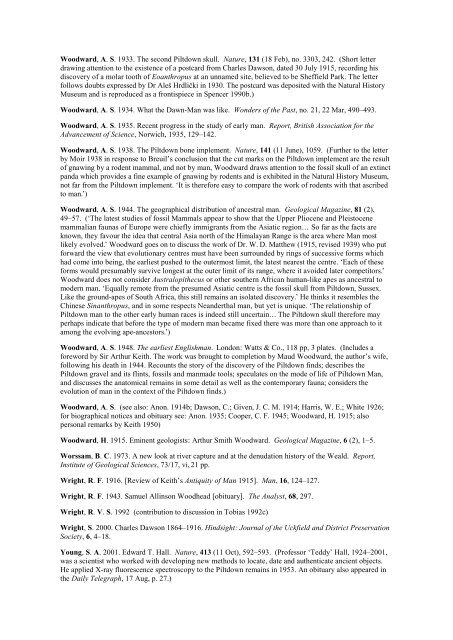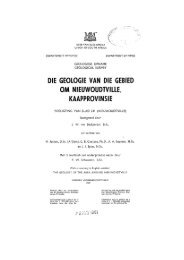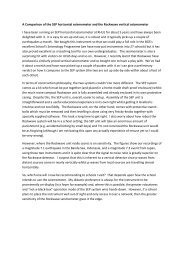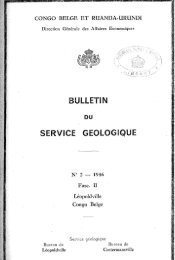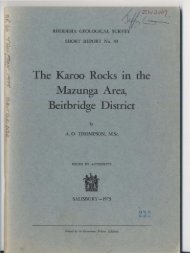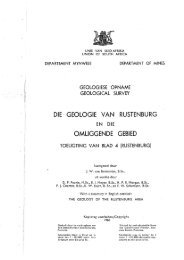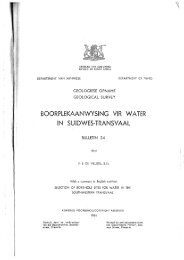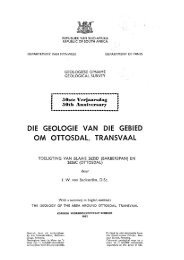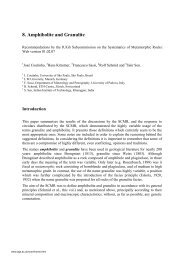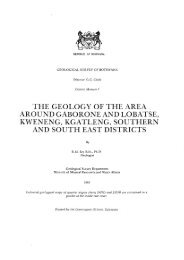Bibliography - British Geological Survey
Bibliography - British Geological Survey
Bibliography - British Geological Survey
You also want an ePaper? Increase the reach of your titles
YUMPU automatically turns print PDFs into web optimized ePapers that Google loves.
Woodward, A. S. 1933. The second Piltdown skull. Nature, 131 (18 Feb), no. 3303, 242. (Short letter<br />
drawing attention to the existence of a postcard from Charles Dawson, dated 30 July 1915, recording his<br />
discovery of a molar tooth of Eoanthropus at an unnamed site, believed to be Sheffield Park. The letter<br />
follows doubts expressed by Dr Aleš Hrdlički in 1930. The postcard was deposited with the Natural History<br />
Museum and is reproduced as a frontispiece in Spencer 1990b.)<br />
Woodward, A. S. 1934. What the Dawn-Man was like. Wonders of the Past, no. 21, 22 Mar, 490–493.<br />
Woodward, A. S. 1935. Recent progress in the study of early man. Report, <strong>British</strong> Association for the<br />
Advancement of Science, Norwich, 1935, 129‒142.<br />
Woodward, A. S. 1938. The Piltdown bone implement. Nature, 141 (11 June), 1059. (Further to the letter<br />
by Moir 1938 in response to Breuil’s conclusion that the cut marks on the Piltdown implement are the result<br />
of gnawing by a rodent mammal, and not by man, Woodward draws attention to the fossil skull of an extinct<br />
panda which provides a fine example of gnawing by rodents and is exhibited in the Natural History Museum,<br />
not far from the Piltdown implement. ‘It is therefore easy to compare the work of rodents with that ascribed<br />
to man.’)<br />
Woodward, A. S. 1944. The geographical distribution of ancestral man. <strong>Geological</strong> Magazine, 81 (2),<br />
49‒57. (‘The latest studies of fossil Mammals appear to show that the Upper Pliocene and Pleistocene<br />
mammalian faunas of Europe were chiefly immigrants from the Asiatic region... So far as the facts are<br />
known, they favour the idea that central Asia north of the Himalayan Range is the area where Man most<br />
likely evolved.’ Woodward goes on to discuss the work of Dr. W. D. Matthew (1915, revised 1939) who put<br />
forward the view that evolutionary centres must have been surrounded by rings of successive forms which<br />
had come into being, the earliest pushed to the outermost limit, the latest nearest the centre. ‘Each of these<br />
forms would presumably survive longest at the outer limit of its range, where it avoided later competitors.’<br />
Woodward does not consider Australopithecus or other southern African human-like apes as ancestral to<br />
modern man. ‘Equally remote from the presumed Asiatic centre is the fossil skull from Piltdown, Sussex.<br />
Like the ground-apes of South Africa, this still remains an isolated discovery.’ He thinks it resembles the<br />
Chinese Sinanthropus, and in some respects Neanderthal man, but yet is unique. ‘The relationship of<br />
Piltdown man to the other early human races is indeed still uncertain... The Piltdown skull therefore may<br />
perhaps indicate that before the type of modern man became fixed there was more than one approach to it<br />
among the evolving ape-ancestors.’)<br />
Woodward, A. S. 1948. The earliest Englishman. London: Watts & Co., 118 pp, 3 plates. (Includes a<br />
foreword by Sir Arthur Keith. The work was brought to completion by Maud Woodward, the author’s wife,<br />
following his death in 1944. Recounts the story of the discovery of the Piltdown finds; describes the<br />
Piltdown gravel and its flints, fossils and manmade tools; speculates on the mode of life of Piltdown Man,<br />
and discusses the anatomical remains in some detail as well as the contemporary fauna; considers the<br />
evolution of man in the context of the Piltdown finds.)<br />
Woodward, A. S. (see also: Anon. 1914b; Dawson, C.; Given, J. C. M. 1914; Harris, W. E.; White 1926;<br />
for biographical notices and obituary see: Anon. 1935; Cooper, C. F. 1945; Woodward, H. 1915; also<br />
personal remarks by Keith 1950)<br />
Woodward, H. 1915. Eminent geologists: Arthur Smith Woodward. <strong>Geological</strong> Magazine, 6 (2), 1–5.<br />
Worssam, B. C. 1973. A new look at river capture and at the denudation history of the Weald. Report,<br />
Institute of <strong>Geological</strong> Sciences, 73/17, vi, 21 pp.<br />
Wright, R. F. 1916. [Review of Keith’s Antiquity of Man 1915]. Man, 16, 124‒127.<br />
Wright, R. F. 1943. Samuel Allinson Woodhead [obituary]. The Analyst, 68, 297.<br />
Wright, R. V. S. 1992 (contribution to discussion in Tobias 1992c)<br />
Wright, S. 2000. Charles Dawson 1864–1916. Hindsight: Journal of the Uckfield and District Preservation<br />
Society, 6, 4–18.<br />
Young, S. A. 2001. Edward T. Hall. Nature, 413 (11 Oct), 592–593. (Professor ‘Teddy’ Hall, 1924–2001,<br />
was a scientist who worked with developing new methods to locate, date and authenticate ancient objects.<br />
He applied X-ray fluorescence spectroscopy to the Piltdown remains in 1953. An obituary also appeared in<br />
the Daily Telegraph, 17 Aug, p. 27.)


